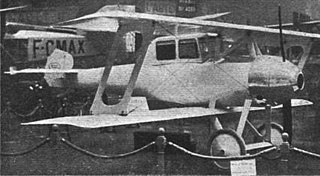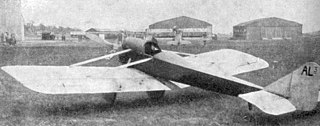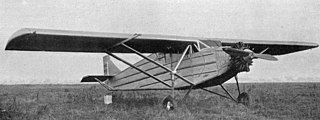The ACAZ T.1 and T.2, very similar to each other, were the first Belgian all-metal aircraft, flown in 1924. They were single-engined touring monoplanes which seated two. Only two were built.

The Latécoère 17 was a French airliner built in 1923 for use on Latécoère's own airline routes between France and Morocco. The prototype was designated the Latécoère 14, reusing the number of an unrelated earlier design that had been rejected. This new aircraft was a parasol wing monoplane of conventional configuration with an enclosed cabin for four passengers and an open cockpit for the pilot. This was Latécoère's first commercially successful design and as production continued, three different engines were fitted.

The Pander D was a small Dutch single-seat sport monoplane, an evolution of the Carley C.12 of 1923. Ten were built.

The Pander P-1 and P-2 were close to-identical single engine Dutch sports aircraft with tandem seats and a parasol wing, first flying in 1929. Only two were built.
The Potez 26 was a single seat fighter aircraft designed and flown in France in the mid-1920s. It did not reach production.

The de Marçay Limousine was a two-seat French touring biplane introduced at the 1919 Paris Aero Salon. A smaller but otherwise very similar single-seater was also there.

The Lachassagne AL 3 was an experimental 1920s French aircraft designed to test a camber-changing wing meant to extend speed ranges. It was flown only briefly but led to a second design with similar features.
The Duverne-Saran 01 was a twin engine, three seat touring aircraft built in France in the mid-1930s. Only one was completed.
The Morane-Saulnier MS.300 and MS.301 were French parasol wing introductory trainer aircraft, first flown in 1930. They differed only in engine type. Neither reached production but were developed into two similar trainers, the MS.230 and MS.315, which were made in large numbers.
The Bréguet Colibri was a low power, single seat French monoplane designed to compete in a 1923 newspaper-sponsored contest between such aircraft. Only one was built.
The Peyret Avionette was a low power, single seat French monoplane which won several first-place prizes at the Congrès Experimental contest of 1923.

The parasol wing, single engine Udet U 8, sometimes referred to as the Limousine, was a three-seat commercial passenger transport designed and built in Germany in 1924. Five were produced and were used by German airlines until about 1928.

The VIH Holland H.1 was a Dutch two seat, low-powered biplane. Only one was built.

The Charmier-Dupuy 10 was a French parasol-winged single seat light aircraft designed for low cost flying. The sole example was first flown in 1924. Over a long career, it was fitted with three different engines and remained on the French register until after World War II.
The Potez 24 A.2 was a mid-1920s French biplane intended to replace the Potez 15 as an army observation aircraft. The further improved and larger Potez 25 was preferred for production.

The Dewoitine 14 was a mid-1920s French civil transport, capable of carrying mixture of passengers and freight. The sole example was used in commercial trials.

The Magni PM.2 Vittoria was an Italian experimental, single seat, parasol wing aircraft built in the mid-1920s. It had a large area aerofoil on each of its single wing bracing struts which could be rotated together or independently to give lift or drag.

The Aviaméta 92 was a French, all-metal, five seat monoplane built in the late 1920s. Three different engines were fitted, and one example flew the first non-stop Paris-Algiers flight in preparation for an abandoned trans-Atlantic attempt.

The Peyret-Nessler Libellule (Dragonfly) was a French two-seat, low-powered parasol wing light aircraft built in 1927 to provide practical but economical flying. It was one of the first of these French avionettes.

The Lumière-de Monge racer was built specifically to compete in the 1921 Coupe Deutsch de la Meurthe, flown at Etampes on 1 October 1921. As well as being fast, it was unusual in being a high wing monoplane which could be rapidly converted into a biplane by adding a smaller lower wing. It crashed fatally before the race and was unable to participate.














